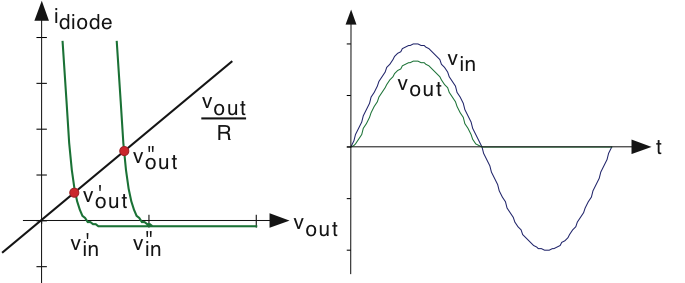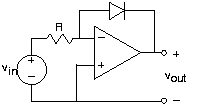| << Chapter < Page | Chapter >> Page > |

The resistor, capacitor, and inductor are linear circuit elements in that their v-i relations are linear in the mathematical sense. Voltage and current sourcesare (technically) nonlinear devices: stated simply, doubling the current through a voltage source does not double the voltage. Amore blatant, and very useful, nonlinear circuit element is the diode ( learn more ). Its input-output relation has an exponential form.

Because of the diode's nonlinear nature, we cannot use impedances nor series/parallel combination rules to analyze circuits containing them. The reliablenode method can always be used; it only relies on KVL for its application, and KVL is a statement about voltage drops around aclosed path regardless of whether the elements are linear or not. Thus, for this simple circuit wehave

We need to detail the exponential nonlinearity to determine how the circuit distorts the input voltage waveform. We can ofcourse numerically solve [link] to determine the output voltage when the input is a sinusoid. Tolearn more, let's express this equation graphically. We plot each term as a function of for various values of the input voltage ; where they intersect gives us the output voltage. The left side, the current through the output resistor, does notvary itself with , and thus we have a fixed straight line. As for the right side,which expresses the diode's v-i relation, the point at which the curve crosses the axis gives us the value of . Clearly, the two curves will always intersect just once for anyvalue of , and for positive the intersection occurs at a value for smaller than . This reduction is smaller if the straight line has a shallowerslope, which corresponds to using a bigger output resistor. For negative , the diode is reverse-biased and the output voltage equals .
What utility might this simple circuit have? The diode'snonlinearity cannot be escaped here, and the clearly evident distortion must have some practical application if the circuitwere to be useful. This circuit, known as a half-wave rectifier , is present in virtually every AM radio twice and each serves very different functions! We'll learn what functions later.

Here is a circuit involving a diode that is actually simpler toanalyze than the previous one. We know that the current through the resistor must equal that through the diode. Thus, thediode's current is proportional to the input voltage. As the voltage across the diode is related to the logarithm of itscurrent, we see that the input-output relation is

Notification Switch
Would you like to follow the 'Fundamentals of electrical engineering i' conversation and receive update notifications?